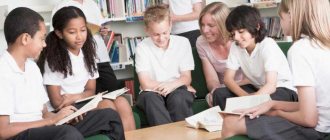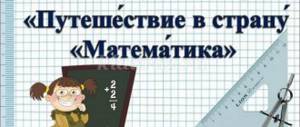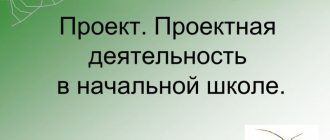The page presents topics for projects in mathematics for grade 5 , which involve research related to ordinary and decimal fractions, the area and volume of the simplest geometric figures, and percentages.
We recommend choosing a topic for a research paper in mathematics together with the project leader or mathematics teacher, taking into account the student’s interests, this will make the work on the project interesting and educational.
These topics of projects in mathematics for grade 5 according to the Federal State Educational Standard are expanded and provide an opportunity for schoolchildren to study the basics of algebra in more depth in the process of research work.
Math project topics for 5th grade
Sample topics for mathematics projects for 5th grade students:
Algebraic fractions. In the depths of centuries, or as the ancients believed. In the world of interest. In the world of puzzles and labyrinths. In the land of knights and liars. The Great Patriotic War in numbers. Greatness of number Types of equations solved in 5th grade. The emergence of numbers. Around common fractions. Heroes of your favorite fairy tales in the world of mathematics. Graphical method of multiplying numbers. Operations with decimal fractions. Birthday of zero Debt and fractions. Ancient measures of length. E.A. Evtushevsky and his achievements in mathematics. Units of measurement, their history. Metric system of measures. Her Majesty Mathematics. Fun math Activities to develop math skills in 5th grade. Problems riddles Problems on movement Problems on percentages Problems on percentages in a person’s life. Problems with fractions with scenes from fairy tales. Problems with economic content in 5th grade. Entertaining problems on the topic “Ordinary fractions”. Fun problems with common fractions. The origin and spread of the concept of “interest”. The meaning of a number in a person’s destiny. From the history of arithmetic operations. From the history of the emergence of ordinary fractions. From the history of measures of length From the history of the number 0. Interactive tasks Interesting facts from the life of animals. Information models of problems involving percentages. The art of guessing numbers. History of the origin of counting History of ordinary fractions. History of accounts How people learned to count Combinatorics in patchwork technique. Combinatorial problems Kingdom of decimals. Curiosities, sophisms, paradoxes in mathematics. Logic problems in mathematics. Favorite village in tasks. Magic squares. Mathematics in painting. Legends of distant antiquity (solving ancient problems) Mathematics in nature Mathematics of the Ancient East. Mathematics of Ancient India. Mathematics and geography Mathematics and chess Mathematical carousel. Mathematical and linguistic features of palindromes. International measures of volume. Sea inhabitants Don't be upset - the percentages will convince you of this. Unusual tasks of Perelman. About the secret of the origin of Arabic numerals. Designation of numbers among different peoples. Ordinary fraction. Adding and subtracting ordinary fractions. Ordinary fractions.
Mathematics project 5th grade “Mathematical fairy tales”
"Fair of educational projects"
Direction Mathematics
Mathematical tales
Project
Completed by 5th grade students
Municipal budgetary educational institution "Bestuzhevskaya secondary school" of Ustyansky district
Istomina Ekaterina, Netsvetaeva Elena, Netsvetaeva Svetlana
Scientific supervisor - mathematics teacher of the Municipal budgetary educational institution "Bestuzhevskaya secondary school" of Ustyansky district
Ilatovskaya Irina Anatolevna
With. Stroevskoe, 2020
| Project passport | Mathematics 5th grade | |||
| Educational organization | MBOU "Bestuzhevskaya Secondary School" | |||
| Project Manager | Ilatovskaya Irina Anatolevna | |||
| Class | 5 | |||
| The project team | Istomina Ekaterina, Netsvetaeva Elena, Netsvetaeva Svetlana | |||
| Project name | Mathematical tales | |||
| Project start and end dates. | January 2020 – April 2020 | |||
| Activities for the development and implementation of the Project | ||||
| Relevance of the project | The relevance of the project - the creation of mathematical fairy tales develops mathematical creativity, contributes to the formation of mathematical concepts, which is a necessary condition for successful study. Creating a fairy tale allows you to instill a taste for independent reasoning, which contributes to the development of mathematical thinking and stimulates the thought process. | |||
| Problematic issues | 1. Are there mathematical fairy tales? 2. Who compiles them? 3. Is it possible to come up with such a fairy tale yourself? | |||
| Objective of the project | Writing math tales | |||
| Project objectives: | Steps (actions to solve problems): | Required resources and sources | ||
| 1. Collect information about fairy tales. | 1. Reading articles on Internet sites. 2.Visit the library. | Internet resources, books, computer. | ||
| 2.Study the structure of a fairy tale. | 1. Read literature and articles | Internet resources, books. | ||
| 3. Find tips and recommendations on how to compose a mathematical fairy tale. | 1. The literature has been studied. 2. We independently drew up a scheme for writing a mathematical fairy tale. | Internet resources, books. | ||
| 4. Compose several mathematical fairy tales and design a book. | 1. Writing fairy tales on the topic of the project. | Mathematics textbook, paper, cardboard, paints, etc. | ||
| Brief description of the completed project | After choosing the topic of the project, we began collecting information about fairy tales, their types, structure, and got acquainted with the mathematical fairy tales of other authors. After that, we composed fairy tales on the topics of the 5th grade mathematics course and designed a book with our fairy tales. | |||
| Project product | Book of Mathematical Fairy Tales | |||
| Efficiency of work on the project | Strengths | Weak sides | ||
| Creating your own fairy tales, developing creative abilities | There is little information about mathematical fairy tales; we had to figure everything out ourselves. | |||
| Project development prospects | In the future, work on the project will continue next year and compose fairy tales about mathematical concepts studied in the 6th grade mathematics course. | |||
| List of used literature, resources, equipment | Lopatina A., Skrebtsova M. Fairytale mathematics Moscow Amrita - Rus 2009. Arutunyan E. B., Levitas G. G. Fairy tales in mathematics Moscow Higher School 1994 Krivin F. Scientists' tales of the Carpathians 1968 https://dic.academic.ru/dic.nsf/enc_literature/4314/%D0%A1%D0%BA%D0%B0%D0%B7%D0%BA%D0%B0 https://ru.wikipedia.org/wiki/%D1%EA%E0%E7%EA%E0 https://sokolova-aa.ru/students-works/matematicheskie-skazki-vypusk-1 | |||
Work report
There are many different fairy tales in the world. Children and adults love them. One day during a math lesson we heard an unusual tale about numbers. We were very interested: are there any other fairy tales like this? Who composes them? How can you come up with such a fairy tale yourself? This determined the theme of our project: “Mathematical Tales.” We chose this topic because we wanted to try ourselves in the role of a storyteller - a writer, we wanted to show our classmates and other children that the serious science of mathematics can be exciting. At the beginning of our research, a problem arose:
1. Are there mathematical fairy tales?
2. Who compiles them?
3. Is it possible to come up with such a fairy tale yourself?
The search for answers to these questions determined the purpose of our work - writing mathematical fairy tales. The project product will be a book with mathematical fairy tales for fifth graders. We have set ourselves the following tasks:
- Analyze the literature on this topic.
- Find tips and recommendations on how to compose a mathematical fairy tale.
- Compose several mathematical fairy tales and design a book.
After selecting the project topic, we began collecting information. We visited the library at our school and got acquainted with the necessary literature. First we learned what a fairy tale is. A fairy tale is a work of a magical nature, usually with a happy ending. As a rule, fairy tales are intended for children. Fairy tales can be folk or literary.
- Folk tale
- a genre of written and oral folk art: a story about fictional events in the folklore of different peoples. Folk tales are considered a powerful source of historical facts and information about the life of a certain people. Over the course of their history, each of the nations has come up with a huge number of instructive stories for adults and children, passing on their experience and wisdom to the next generations. Folk tales reflect human relationships and changes in moral principles, show that basic values remain unchanged, teach to draw a clear line between good and evil, joy and grief, love and hate, truth and lies.
- Literary fairy tale
- a fairy tale closely related to a folk tale, but belongs to a specific author. Typically, an author's work is a subjective adaptation of a folk story, however, new stories are found quite often. The folk tale historically precedes the literary one.
Then we found material about the structure of a fairy tale. Here's what we learned about the structure of a folk tale. The Russian folk tale is divided into three parts. The fairy tale begins with the beginning. The opening contains information about the main characters, time and place of events. It helps start a fairy tale. For example, “once upon a time there was an old man, and he had three sons...” - and we all understand that a fairy tale has begun. Fabulous events follow. In fairy tales, there are triple repetitions of certain events and trials of the main character. But now the fairy tale ends, how to end it? The ending helps the narrator. For example, “here they didn’t wait and talk for a long time - a merry feast and for the wedding” or “and they began to live well, without knowing any trouble.” Sometimes the narrator refers to a saying. A saying is a short funny story, a joke, a few words that introduce you to the world of a fairy tale and help the listener get into the mood of a fairy tale. For example: “The fairy tale will soon be told, but the deed will not be done soon.”
We realized that mathematical fairy tales are different from folk and literary ones. We got acquainted with mathematical fairy tales by other authors. Most of the fairy tales we found were written by schoolchildren, but there are also books with mathematical fairy tales. “Fairytale Mathematics” by A. Lopatina, M. Skrebtsova, “Scientific Tales” by Felix Krivin. We began to look for answers to the questions: Who could be the hero of a mathematical fairy tale? How does it differ from a literary or folk tale? We learned that the heroes of a mathematical fairy tale can be: figures (triangle, square, rectangle, etc.), numbers and numbers. In addition, drawing instruments and writing utensils - rulers, compasses, pens, pencils - can become heroes of mathematical fairy tales. We did not find the structure of a mathematical fairy tale, unlike an ordinary one, but we found out that the content of such a fairy tale necessarily includes a mathematical concept or property. On one of the sites we read the requirements for a mathematical fairy tale. We thought about them and formulated them in our own way, and the following came out: 1. It is necessary to include a mathematical concept or property of a concept in the storyline. 2. Maintain consistency and logic of the plot. 3.Try to make the plot complete. 4. The plot must have its own originality.
Creating mathematical fairy tales requires not only the ability to fantasize on mathematical topics, but also the ability to speak correctly and use mathematical concepts. We completed the work by composing several fairy tales, drawing illustrations for them, and selecting ready-made pictures. During the work, we encountered difficulties in finding material on how to compose a mathematical fairy tale. In practice, it was very difficult to come up with a plot so that it would not be repeated in other existing fairy tales.
Assessing the performance of each project team member
| When | Full name of the participant | What exactly did you do? | |
| January February April | Istomina Ekaterina | 1. Searching for information in the library. 2. Writing a fairy tale. 3. Book design. | |
| January February March | Netsvetaeva Elena | 1. Searching for information on Internet sites. 2. Writing a fairy tale. 3. Typing fairy tales on a computer. | |
| February March April | Netsvetaeva Svetlana | 1. Writing a fairy tale. 2. Typing fairy tales on a computer. 3. Design of the project. |
Conclusion.
Having finished our project, we can say that we were not able to come up with fairy tales about all mathematical concepts for the 5th grade course. This happened because the process of composing a fairy tale is very labor-intensive. If we started the work again, we would try to involve classmates in composing fairy tales. Working on the project showed that expressing one’s thoughts while constructing the plot of a fairy tale is not so easy. It takes a lot of time to compose even one short but interesting fairy tale. We managed to solve the problems and achieve the goal of our project with the help of the created book of fairy tales. Writing a fairy tale allows you to reason independently, contribute to the development of mathematical thinking, and stimulate the thought process.
8
Topics for research papers in mathematics in grade 5
Sample topics for research papers in mathematics for 5th grade students:
Olympiad problems for 5th grade. Origami and mathematics Ornament is an imprint of the soul of the people. Ornaments and patterns Oh, those fractions Oh, those percentages! The concept of "fractions". History of the study. The emergence and development of numbers. Practical application of percentages in our lives. Techniques for solving problems involving percentages. Application of percentages in life. Prime numbers. Is their story so simple? Percentage calculations and calculations. Interest calculations for every day. Interest in our lives. Interest in the modern world. Percentages around us Percentages and fractions. Interest. Ways to solve problems. Journey to the land of fractions. Travel to the land of interest. Journey to the planet of fractions. Expanding parentheses. Solving problems with fractions Solving problems with percentages. Sieve of Eratosthenes Symmetry around us Number systems Perfect numbers Perfection of perfect numbers. Sports and mathematics Old problems on fractions. Old problems with common fractions. Ancient and fairy-tale problems" and some of their solutions. Old Russian problems on fractions. Ancient Russian measures or ancient mathematics. The sum of the angles of a triangle on a plane and on a cone. Accounts of ancient civilizations Such different and identical accounts. Heavyweight Numbers among different peoples of the world. Four actions of mathematics. Mersenne numbers.
Go to page: Research papers in mathematics Topics of research papers in mathematics
If you liked the page, share it on social networks:



